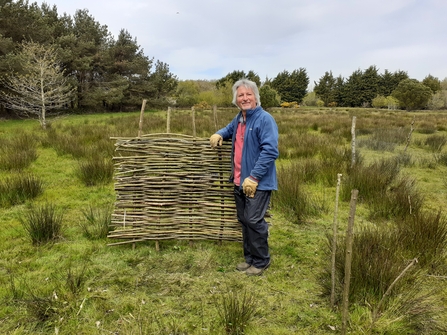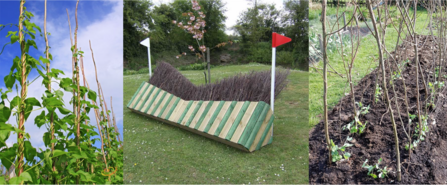
Derek Wiggall, one of our Midweek Muckers, with his first wattle panel made earlier this year, taken by Reserves Officer, Tricia.
Derek Wiggall, one of our Midweek Muckers, with his first wattle panel made earlier this year, taken by Reserves Officer, Tricia.

Derek Wiggall, one of our Midweek Muckers, with his first wattle panel made earlier this year, taken by Reserves Officer, Tricia.
February will see the resumption of coppicing at Close Sartfield. The cut material (willow and birch) has a variety of uses and these products will be available for purchase. This includes:
For availability and prices please contact MWT Reserves Officer, Tricia - 494143 or tricia@mwt.im

Bean Poles, a brash XC jump and pea sticks. All can be made with our coppiced products.
Coppicing as a tradition and why we do it.
Almost all woodlands in Britain have been managed and coppicing is a traditional silvicultural system used extensively since Neolithic times.
Some trees die when cut down but many others (including hazel and willow) coppice i.e. the cut stump sends up shoots and becomes a coppice stool from which successive crops of poles can be cut. Coppicing is a very efficient method of harvesting wood, as the new shoots can grow more than 5cm a day. Coppice products have been used as building materials, charcoal, providing bark for tanning, pea and bean sticks, hurdles, thatching spars, and stakes and binders for hedging. Some material harvested from other reserves has already been used for hedge laying around the Island. The conservation value of coppicing means it continues to play an important role in the British landscape and it is for its conservation and wildlife benefits that we have undertaken coppicing at Close Sartfield since 2000.
Traditionally areas felled were small being based on the amount one or two men could cut and process in a winter season. In order to reduce edge effects coppice blocks need to be a half to one acre in extent.
Traditionally, coppice is cut in winter (October to March) because it is easier to work without the presence of foliage, there is a full season’s growth for the new shoots and in the past woodsman had other work to do in the summer. At Close Sartfield coppicing takes place January – March this avoids bird nesting and reduces the amount of regrowth eaten by the sheep.
Coppicing is practised on a series of rotations of anything from 4-35 years depending on the tree species and the purpose for which the coppice poles will be put. At Close Sartfield there are two blocks of coppice which are cut every five years. Mature willow is left between the blocks for birds and bats to roost and nest.
The conservation benefits of coppice are as follows: